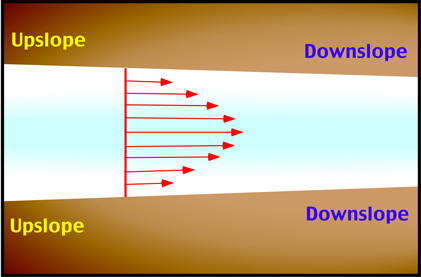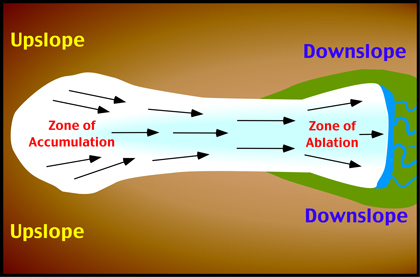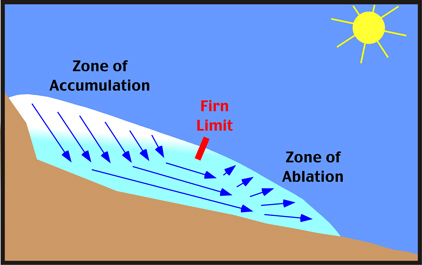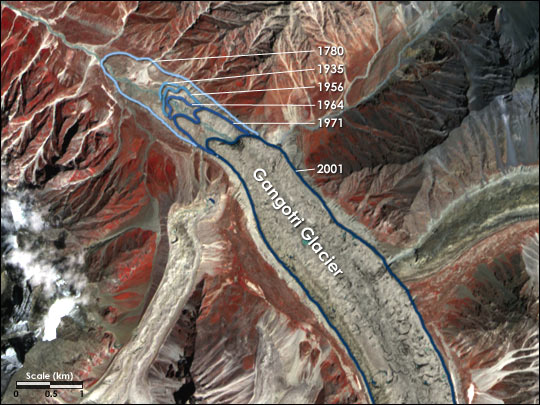Growth of Glaciers
Ice that makes up glaciers originally fell on its surface as snow. To become ice, this snow underwent modifications that caused it to become more compact and dense. Glacial ice has a density of about 850 kilograms per cubic meter. The density of snow ranges from about 50 to 300 kilograms per cubic meter (the density of fresh water is approximately 1000 kilograms per cubic meter). After the snow falls, the crystals can be reduced by the effects of melting and sublimation. Scientists call this process ablation. For most glaciers, ablation is a phenomena dominant in the summer months. The snow also undergoes physical compaction through melting and refreezing. At first, these processes cause the original snowflakes to be transformed into small round crystals. This partly melted, compressed snow is called névé. Névé has a density exceeding 500 kilograms per cubic meter. If the névé survives the ablation that occurs during the summer months it is called firn. When this process happens year after year, a number of layers of firn can accumulate. Accumulation then causes a further increase in density, modifying the firn into glacier ice, as the lower layers of firn are compressed by the weight of the layers above. On average, the transformation of névé into glacial ice may take 25 to 100 years.
Glacier Movement
To be called a glacier, a mass of ice must be capable of motion. Glacial movement occurs when the growing ice mass becomes too heavy to maintain its rigid shape and begins to flow by plastic deformation. In most mountain glaciers, flow of ice begins with accumulations of snow and ice greater than 20 meters.
Flow rates within the various regions of a glacier are not uniform. From directly above, the middle of the glacier appears to flow with the greatest speed (Figure 10ae-1). At the margins of glacier, surface movement is slowed down because of the frictional effects of the valley wall. Looking at the glacier in cross-section, we notice that the bottom of the glacier also moves slowly, once again, because of the influence of frictional forces (Figure 10ae-2).

| Figure 10ae-1: Overhead view of an alpine valley glacier showing the relative speed of ice movement. |
| Figure 10ae-2: Long cross-section view of an alpine valley glacier showing the relative speed of ice movement. |
Figure 10ae-3 illustrates the typical pattern of ice flow in a valley glacier. In the upper reaches of the glacier, ice and snow accumulate in a broad basin formed by the effects of physical weathering and erosion. As the glacier proceeds to move downslope, the flow lines of the ice begin to converge because of the narrowing of the valley. This convergence causes a compression of the ice flow in central section of the glacier. At the terminal end of the glacier, flow lines spread out as the ice is no long constricted by valley walls.

| Figure 10ae-3: Diagram showing ice flow patterns along the entire length of an idealized alpine glacier. |
The velocity of flow of glacier ice is influenced by a variety of factors. Some of the more important factors are the gradient of the valley floor, the temperature and thickness of the ice, and the constriction caused by the valley walls. The movement of ice over the ground in most temperate glaciers is enhanced by a process known as basal sliding. The immense pressure caused by the weight of the overlying glacial mass causes the ice making contact with the ground to melt because of pressure, despite subzero temperatures (pressure melting). The melting ice then forms a layer of water that reduces the friction between the glacial ice and the ground surface. This water then facilitates the movement of the ice over the ground surface by producing a layer with very little friction. Because of basal sliding, some glaciers can move up to 50 meters in one day. However, average rates of movement are usually less than 1 meter per day. Cold glaciers tend to move very slowly because there is no basal sliding. Movement in these glaciers takes place mainly due to internal slippage of the ice over the ground.
Glacier Mass Balance
Scientists often view glaciers as systems that are influenced by a number of inputs and outputs. The main inputs to the glacial system are water, in the form of snow, and eroded sediments that are picked up by the moving ice. Water leaves the glacial system when ice is converted into water or vapor. Sediment is deposited at the base of the glacier as till and at its terminal end as moraines or materials reworked by glaciofluvial processes.
We can also use a systems approach to help us understand why glaciers expand and shrink, and advance and retreat. This type of modeling is referred to as glacier mass balance. The mass balance of a glacier involves two main components: accumulation of snow in the glacier's zone of accumulation and the ablation of ice in the zone of ablation (Figure 10ae-4). The zone of accumulation occurs in the upper reaches of the glacier where yearly additions of snow exceed losses due to melting, evaporation, and sublimation. The surface of this zone is covered by snow throughout the year. Below the zone of accumulation is the zone of ablation. In this zone, the losses of snow and ice from melting, evaporation, and sublimation are greater than the additions. The line that separates these two areas is called the firn limit or snow line.

| Figure 10ae-4: The following illustration describes the major components of glacier mass balance. Additions to the glacial system occur in the zone of accumulation where snow is converted into glacial ice over time. This ice then flows downslope into the zone of ablation. In the zone of ablation, losses occur from the glacier from the melting, evaporation, and sublimation of solid and liquid forms of water. The firn limit marks the separation point between the two zones. Above the firn limit snow is able to survive the summer season. |
Forward flow of glacial ice is controlled by gravity and the accumulation of snow in the zone of accumulation. If losses due to ablation are identical to accumulations, the glacier will appear to be standing still in spite of the fact that the ice is actually moving forward. Advance of the glacier's terminus occurs when net accumulation is greater than net ablation. This situation is shown in the animation in Figure 10ae-5.
Figure 10ae-5: Advance of the glacier's terminus occurs when the addition of snow in the zone of accumulation exceeds losses of ice in the zone of ablation. In this animation, the firn line moves forward as the zone of accumulation expands with increasing snowfall. (To view this animation your browser must have Apple's QuickTime plug-in. The QuickTime plug-in is available for Macintosh and Windows operating system computers and can be downloaded FREE from the World Wide Web site www.apple.com/quicktime). |
Figure 10ae-6 models the condition of glacial retreat. Glacial retreat takes place when net accumulation is less than net ablation.
Figure 10ae-6: Retreat of the glacier's terminus occurs when the addition of snow in the zone of accumulation is less than the losses of ice in the zone of ablation. In this animation, the firn line moves upslope as the zone of accumulation shrinks with decreasing snowfall. (To view this animation your browser must have Apple's QuickTime plug-in. The QuickTime plug-in is available for Macintosh and Windows operating system computers and can be downloaded FREE from the World Wide Web site www.apple.com/quicktime). |
Ideally, the rate of flow and movement of the glacier's terminus should be controlled by net accumulation and net ablation. This relationship, however, is not temporally immediated. In many glaciers, there are significant time lags between one year's net accumulation and net ablation and the corresponding movement of the glacier. Sometimes this lag can be in the order of several decades when the glaciers are quite large. Some glaciers can experience a rapid forward surge as great as 10 to 20 meters per day. This phenomenon is believed to be caused by large inputs of snow sometime in the past.
Eventually, all glacier ice is lost in the zone of ablation by the processes of melting, evaporation, and sublimation. Another process that can remove mass from a glacier is calving. This process occurs in glaciers whose terminus reaches large bodies of water. Calving involves the separation of portions of the glacier ice into the water body. Many icebergs enter the oceans of the world from the calving of the Greenland and Antarctic glaciers.
Today most glaciers are retreating because of the general warming of global temperatures since the beginning of this century (Figure 10ae-7). This indicates that the mass balances of these glaciers are negative because of less snow accumulating or higher levels of ablation. During the Little Ice Age, when global temperatures were cooler than present, many glaciers over much of the world made strong advances.

| Figure 10ae-7: This false-color satellite image shows the retreat of the Gangotri Glacier, one of the largest glaciers in the Himalaya. Gangotri has been receding since 1780. Research work has shown that the retreat of this glacier accelerated after 1971. (Source: NASA Earth Observatory). |